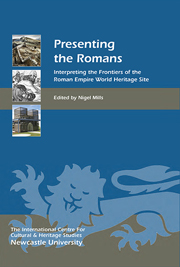Book contents
- Frontmatter
- Contents
- List of Illustrations
- Acknowledgments
- List of Abbreviations
- Preface
- Introduction: Presenting the Romans – Issues and Approaches to Interpretation
- 1 Tradition and Innovation: Creating a New Handbook to the Roman Wall
- 2 Re-enactment and Living History – Issues about Authenticity
- 3 Reconstruction Drawings: Illustrating the Evidence
- 4 Images from the Past: Fibulae as Evidence for the Architectural Appearance of Roman Fort Gates
- 5 Multimedia Interpretation Techniques for Reconstructing the Roman Past at the Limes Museum in Aalen and at the Limes in Baden-Württemberg
- 6 Vindonissa: Changing Presentations of a Roman Legionary Fortress
- 7 Bringing to Life the Ancient City of Viminacium on the Danube
- 8 An International View of Reconstruction
- 9 A Roman Museum for Vienna
- 10 Woerden – Hoochwoert (Dutch Limes): Showing the Invisible
- 11 Mainlimes Mobil: Presenting Archaeology and Museums with the Help of Smartphones
- 12 Voices from the Past: Presenting (re)Constructed Environments through Multimedia Technologies
- 13 Digital Reconstruction and the Public Interpretation of Frontiers
- 14 Information, Disinformation and Downright Lies: Portraying the Romans
- 15 Romanes eunt Domus?
- 16 The Living Frontier: the Passing of Time on Hadrian's Wall
- 17 The Hadrian's Wall Interpretation Framework: Audience Research
- 18 The Hadrian's Wall Interpretation Framework
- 19 Applying the Hadrian's Wall Interpretation Framework
- List of Contributors
- Index
- Heritage Matters
6 - Vindonissa: Changing Presentations of a Roman Legionary Fortress
Published online by Cambridge University Press: 05 September 2013
- Frontmatter
- Contents
- List of Illustrations
- Acknowledgments
- List of Abbreviations
- Preface
- Introduction: Presenting the Romans – Issues and Approaches to Interpretation
- 1 Tradition and Innovation: Creating a New Handbook to the Roman Wall
- 2 Re-enactment and Living History – Issues about Authenticity
- 3 Reconstruction Drawings: Illustrating the Evidence
- 4 Images from the Past: Fibulae as Evidence for the Architectural Appearance of Roman Fort Gates
- 5 Multimedia Interpretation Techniques for Reconstructing the Roman Past at the Limes Museum in Aalen and at the Limes in Baden-Württemberg
- 6 Vindonissa: Changing Presentations of a Roman Legionary Fortress
- 7 Bringing to Life the Ancient City of Viminacium on the Danube
- 8 An International View of Reconstruction
- 9 A Roman Museum for Vienna
- 10 Woerden – Hoochwoert (Dutch Limes): Showing the Invisible
- 11 Mainlimes Mobil: Presenting Archaeology and Museums with the Help of Smartphones
- 12 Voices from the Past: Presenting (re)Constructed Environments through Multimedia Technologies
- 13 Digital Reconstruction and the Public Interpretation of Frontiers
- 14 Information, Disinformation and Downright Lies: Portraying the Romans
- 15 Romanes eunt Domus?
- 16 The Living Frontier: the Passing of Time on Hadrian's Wall
- 17 The Hadrian's Wall Interpretation Framework: Audience Research
- 18 The Hadrian's Wall Interpretation Framework
- 19 Applying the Hadrian's Wall Interpretation Framework
- List of Contributors
- Index
- Heritage Matters
Summary
Introduction
The protection and presentation of archaeological structures is a century-long tradition in Vindonissa. Whereas older models and reconstructions tried to recreate the ancient situation as closely as possible, current approaches to presentation work consciously with abstraction and schematising. They invite the viewer to experience the process and methods of presentation and do not presume to offer definitive solutions. They attempt, rather, to entice the viewer into antiquity for a moment, to stimulate the imagination. Knowing the subjectivity of all history writing, the viewer is allowed, to a large extent, to create his own history of Roman Vindonissa.
The Via et Porta Praetgria Archaeological Site
At Vindonissa, a legionary fort in northern Switzerland, systematic field research began at the end of the 19th century when, in 1897, the amphitheatre was rediscovered and, shortly after, restored and presented to the public (Frei-Stolba et al 2011). The amphitheatre marks not only the beginning of systematic excavation, but also the beginning of preservation and presentation of roman ruins at this important site on the roman frontier. It is interesting to note that since the beginning of field archaeology at Vindonissa, the restored roman remains have been used for different purposes including theatrical performances and even church services.
- Type
- Chapter
- Information
- Presenting the RomansInterpreting the Frontiers of the Roman Empire World Heritage Site, pp. 55 - 64Publisher: Boydell & BrewerPrint publication year: 2013



